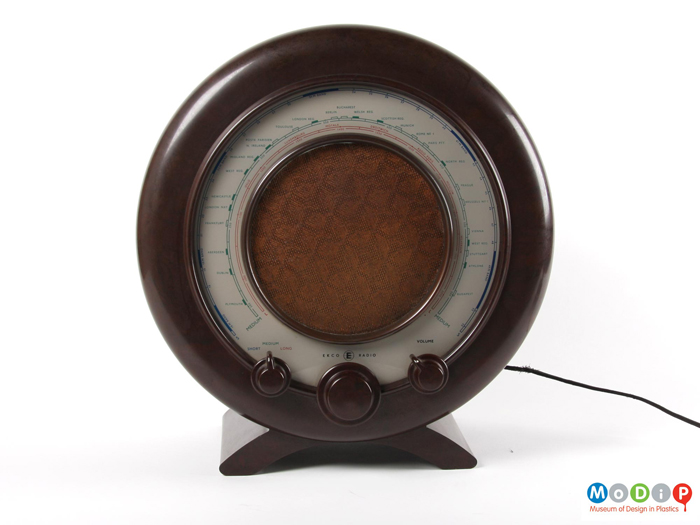Ekco radio
The architect, Wells Coates, designed the first in the series of this radio but who continued the series?


Case number - AIBDC : 006891
An Ekco type A22 radio manufatured by E.K. Cole of Southend-on-Sea in 1945. This model has a 360 degree tuning dial, the case is of 'Walnut' bakelite and it has a 'Florentine bronze' loud speaker surround. This was the last of a series of five round designs by E.K. Cole, the first one, the AD-65, having been desinged by architect Wells Coates in 1932. In 1945 the A22 was shown in a moulded green cabinet, a one-off non standard colour produced specially for the Britain Can Make It exhibition.
View more images on the MoDiP site
View more images on the MoDiP site
| Designer | Unknown - Wanted |
| Manufacturer | E K Cole |
| Country | UK |
| Date | 1945 |
| Dimensions | height 360 mm, width 335 mm, depth 200 mm |
| Materials | plastic, bakelite - generic term, PF, phenol formaldehyde, Perspex, acrylic, PMMA, polymethyl methacrylate |
| Method | compression moulded |
| Colour | brown |
Join the hunt at: 10mostinvolved
Facebook Feed
30/05/14
30/05/14
30/05/14
30/05/14
31/05/14
31/05/14
31/05/14
01/06/14
01/06/14
01/06/14
08/06/14
08/06/14
09/06/14
09/06/14
10/06/14
19/06/14














 #10
#10 #10;</body></html>" />
#10;</body></html>" />


Case notes
Ekco radio: Case AIBDC : 006891
This object is part of a trial to see if giving specific guidance on research methods makes the game a more successful means of obtaining information about the objects featured.
Such a modern design so its interesting that the phenol formaldehyde, better known as Bakelite. has an old-fashioned walnut effect. It's based on a stunning design by Wells Coates but we want to know who it was that continued the series. Books and websites on the hstory of radios may well have the answer as may people at Southend Museum where Ekco was located.
Walnut finished radios exhibited beside brightly coloured ones at th British Industries Fair of 1935
01/06/14
Thank you, Chief Agent Holdsworth, for this stunning image. The capiton says: 'Radio cabinets and other mouldings on display on the Ecko stand at the British Industries fair of 1935. Cabinets inclded ones in simulated walnut, green onyx, pearl ivory amd black with chrome trim'. What a splendid sight it must have been.
The case is solved: it was designed by Wells Coates
10/06/14
Special Agent Harman Powell was a young designer at Ekco at the end of the period when Wells Coates was presenting designs there under contract. He tells us that there were 9 variations of this radio between 1934 and 1945 and that the moulding tools were made in such a way that changes could be made without incurring major costs. Wells Coates' preference was for black phenolic with chrome plated trim. The walnut finish of the MoDiP example was aimed at the more traditional home market. He also says that he was stunned when he saw bright colours at the Festival of Britain in 1951. It showed 'what could be aimed for...'. To read Harman Powell's text please go to the evidence locker.
was a young designer at Ekco at the end of the period when Wells Coates was presenting designs there under contract. He tells us that there were 9 variations of this radio between 1934 and 1945 and that the moulding tools were made in such a way that changes could be made without incurring major costs. Wells Coates' preference was for black phenolic with chrome plated trim. The walnut finish of the MoDiP example was aimed at the more traditional home market. He also says that he was stunned when he saw bright colours at the Festival of Britain in 1951. It showed 'what could be aimed for...'. To read Harman Powell's text please go to the evidence locker.
Case solved
Designer: Wells Coates
Participating agents: David Harman Powell and Ian Holdsworth